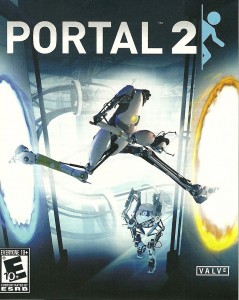Portal 2
Developer: Valve
Publishers: Valve & EA
Genre: First-Person Puzzle/Platformer
Price: $59.99 (PS3, Xbox 360) $49.99 (PC)
Platform: Xbox 360, PS3 (reviewed version), PC
Buy Now ($64.90) US
Buy Now ($92.00) AU
The original Portal was a masterpiece of game design. Featuring puzzles which ranged from clever to damn-that-was-clever and comedy blacker than any mesa, it offered gamers a short but sweet trip through Aperture Science’s Enrichment Center. On top of all that, it was also initially released alongside Half Life 2 (and its episodic expansions) and Team Fortress 2, making it a part of one of the best deals ever conceived. This gives Portal 2 a lot of high expectations to live up to. Can the formula behind Portal be expanded for something even greater? Can it stand on its own as a full-price retail release? Will it be plagued with sequel-itis? Here’s the rundown.
Story:
Portal 2 actually features two entirely separate campaigns, one for the socially maladjusted single-player type, and one for the overly dependent cooperative types. While these two tales are tangential to some extent, players won’t know how exactly they tie into one another until they’ve completed both.
The single-player campaign stars Chell, the protagonist of the first game, who has been in stasis ever since a Party Escort Bot recovered her following the ending of Portal. Upon being awoken, Chell finds herself in what looks like a cheap hotel room as a robotic voice guides her through a standard exam to check for side effects to the hibernation. Shortly after, she is put back to sleep only to be roused once more by the delightfully awkward (and delightfully British) voice of Wheatley. Wheatley is a robotic personality sphere who wants to help Chell escape from the facility. A significant chunk of time has clearly passed since you went to sleep as the cheap motel room has become quite dilapidated and the “relaxation facility” is in a state of meltdown (hence your current escape plan).
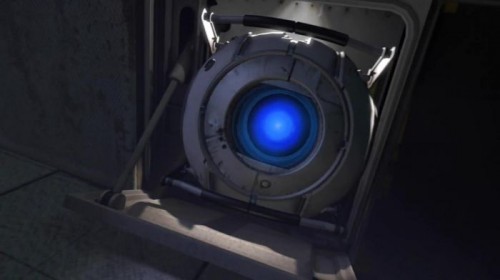 Wheatley definitely does not remind me of Guilty Spark. Nope, not a bit.
Wheatley definitely does not remind me of Guilty Spark. Nope, not a bit.
Unfortunately for Chell, this escape takes her right back to the enrichment center where she needs to recover the Portal gun in order to get out of the Aperture facility. During this trek our duo stumbles upon the deactivated GLaDOS, and through a mix of incompetence and circumstance turn her into a reactivated GLaDOS. From here on out the science-loving, fake-cake-offering dictator of the enrichment center is back in charge, sending Chell through a series of increasingly deadly tests. Meanwhile, Wheatley attempts to find a way to get Chell and himself to safety and shut down the test-obsessed bot once and for all.
While this is as far as I can describe the story of Portal 2 without letting slip some heavy spoilers, I will say that there is much much more to it than this. This sequel is far from just a retelling of the original and will offer players a first-hand look at the history of Aperture Science, its deranged founder, Cave Johnson, and the loveable GLaDOS herself. It will also include potatoes, a bird, deadly deadly neurotoxin, and a bit about the moon. If that sounds like it makes no sense, just play the game. I promise it’s excellent.
The coop campaign features Atlas and P-body, two cooperative testing units who were designed to run through specially designed enrichment center facilities that no fleshy meatbag could have hoped to solve. GLaDOS guides them through these tests as training for their real mission: to find and rescue a vault full of humans. There isn’t much more to it than that. Atlas and P-body simply go through chamber after chamber solving tests and helping GLaDOS recover “unimportant” blueprints and pass codes that don’t really mean anything. I’m sure it’s all entirely innocent, right?
While it may sound barebones, there is a lot of humor in the coop campaign as GLaDOS praises one partner while reprimanding the other, or offers backhanded compliments and insulting comparisons to the imperfect human test subjects these two were designed to replace. The ending is equally entertaining when players finally reach the conclusion of Atlas and P-body’s journey and are greeted with a credit sequence to rival Still Alive.
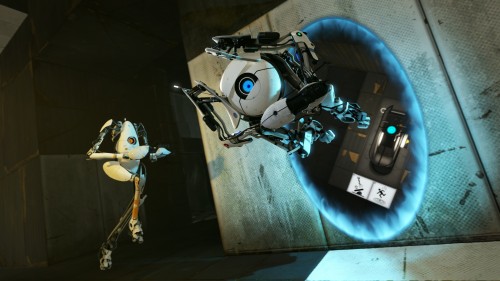 P-body (left) and Atlas become the best of buddies throughout their campaign.
P-body (left) and Atlas become the best of buddies throughout their campaign.
Gameplay
In order to describe the gameplay of Portal 2, it is important to talk about what has been added to the original formula. The things that have been carried over from the first game, the portals, momentum flinging, buttons, cubes, turrets, all still function in the same basic way as they did previously. The new elements to the puzzles, however, will drastically change the way players will be thinking with portals from now on.
One addition, which is actually more of a substitution, is the use of lasers in Portal 2. These can be reflected and redirected using mirror cubes in order to activate parts of a puzzle or to burn away certain obstacles. These seem to have replaced the energy balls from the original Portal which would often bounce around a chamber out of control and end up murdering the player thanks to a misplaced cube. These new “thermal discouragement beams” won’t kill a player immediately, but will simply knock them back a little to keep them from passing. The aptly named aerial faith plates will launch players across a room like a catapult, sometimes toward victory, other times toward certain death.
Also added to Portal 2’s arsenal of tests are the hard light surfaces, which can be used as bridges to walk across or shields from turret fire. These are essentially beams of light which the players can traverse when the need arises. The excursion funnel, another new testing apparatus, is a gravity field which will slowly move players (or objects) in whatever direction it is aimed. The combination of these elements offers some really surprising test chambers and allows for segments which can be equally mind-blowing as a player’s first experience with portals.
Finally, the last additions to GLaDOS’s toolbox of testing equipment are the gels. Repulsion, propulsion, and conversion gels can all be used in conjunction with one another in order to reach one’s destination. Repulsion gel (blue) acts as a trampoline-like surface which will allow for higher jumps or enable the players to bounce off of walls. Propulsion gel (red) reduces static friction and allows for inhuman running speed. Compared to these two, conversion gel (white) may seem a bit boring at first. It will convert any surface onto which it is painted into a nice blank canvas for portals. While it’s not quite as exciting as running faster than a speeding bullet or leaping tall buildings in a single bound, it proves quite useful when you’re given the ability to paint an entire room with portal-ready surfaces.
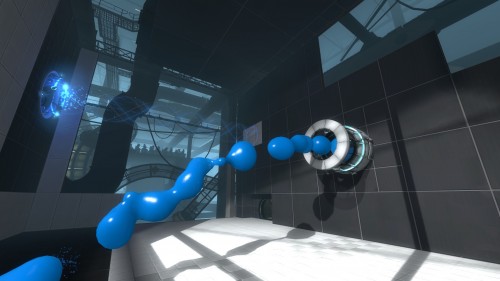 Repulsion gel is just one of the new game-altering mechanics in Portal 2.
Repulsion gel is just one of the new game-altering mechanics in Portal 2.
The difficulty in Portal 2 is curved perfectly, starting out with simple explanatory puzzles which will introduce new elements throughout the game. Towards the end, some of the puzzles are devilishly tricky, and there were several rooms where I was forced to sit and think for a good deal of time. Other times, the answer was all too simple but I was off on the completely wrong track. Much like the incinerator escape segment from Portal 1 where I didn’t know how to open doors so I spent about an hour attempting to portal fling myself hard enough into one to bash it open, when your mind is trying to find a spot for a portal or the right place to put some repulsion gel, often the simplest answer eludes you.
On coop as well, the difficulty will ramp up in each section as you get used to the new tools that are given to you. I personally played through the coop campaign first and while I don’t think it really makes much of a difference, I would probably recommend doing it that way if you can. The reason for this is that during the coop campaign, GLaDOS explains the gels, discouragement beams, hard light surfaces, and excursion funnels as you encounter them, whereas the single player campaign does less hand holding and expects you to figure out each new element. Really the game can be played in either order as the basics of these devices are easy enough to figure out while the advanced techniques are always difficult to master.
The only thing missing from the game is the inclusion of the advanced chambers and challenges from the first game. These challenge rooms would increase the difficulty significantly for each test or task you with completing a chamber using the least portals, footsteps, or time. In Portal 2, you can replay each chapter of the game from the main menu and they still offer the option of adding developer commentary, but there is no hard mode or advanced stages to be seen. The game still maintains a good deal of replayability, and players can challenge themselves or their friends to master each level, but there is no built-in way of tracking such things.
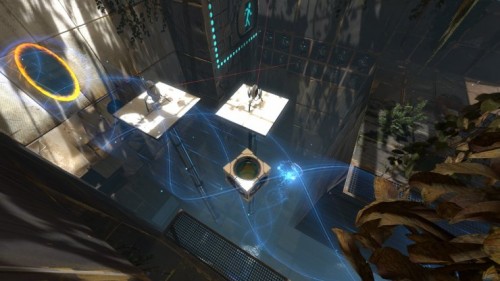 Excursion funnels acts as a force which can move things through portals.
Excursion funnels acts as a force which can move things through portals.
Presentation:
The graphics in Portal 2 are pretty much what you would expect from a AAA title on the current generation consoles. The clean white interiors of the Aperture enrichment center are now stained and aged, with walls falling down and plants growing where the facility has been neglected during your years and years of hibernation. Without GLaDOS to keep things running smoothly, Aperture Science has pretty much gone to hell. You know, more so than previously. The textures and gritty detail is more reminiscent of Half Life 2’s City 17 than the testing facility of Portal.
The animation is excellent in Portal 2, and while Chell is the only human around (and is mostly invisible except for the rare peek you’ll get through your own portals), the robot inhabitants of the enrichment center all move realistically, with tons of moving parts and rotating spheres. The facility itself also features some smooth animation where GLaDOS is literally rebuilding the place before your eyes. Panels will shift around in order to create a ramp or to fix a wall and the robotic arms supporting them will struggle after years of inactivity. Of equal quality although quite opposite are the times when parts of the facility are destroyed, as untended supports fail or machines malfunction. Watching a floor collapse beneath you or a walkway crumble under the weight of a toppled pillar is rather impressive.
The sound team at Valve that was behind Portal 2 really did an excellent job of bringing the facility and its robot workers to life. One small touch which I really appreciated were the unique sounds which would play while you were using some of the test elements. Aerial faith plates, propulsion gel, and repulsion gel each have a sort of subtle theme that plays while the player is interacting with them. This adds to the soundtrack’s ambient score by reflecting your actions through sound. Some puzzles also add layers to the soundtrack as a particular test chamber approaches completion, especially in chambers where there are several devices that need to be activated at once. This gives players and audio cue as to how close they are to finishing a test, and a small aural reward once everything is in place.
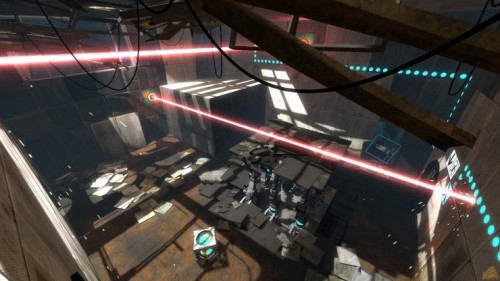 Lasers now activate puzzles in the clearly deteriorating Aperture enrichment center
Lasers now activate puzzles in the clearly deteriorating Aperture enrichment center
The voice talent of Stephen Merchant as Wheatley (who also co-directed the British version of The Office, talk about talent), the eternally gruff J K Simmons as Aperture’s founder, Cave Johnson (probably best known by gamers as J Jonah Jameson from the recent Spiderman films or by me as Mac MacGuff from Juno), and Ellen McLain as the delightfully deranged GLaDOS (McLain, apart from singing opera, voices Team Fortress 2’s announcer and the combine overwatch in Half Life 2) all provide fantastically comedic performances. The humor in Portal 2, much like in its predecessor, is delivered entirely deadpan and is unapologetically dark. After the fourth time GLaDOS calls you fat it still doesn’t lose any of its charm.
Finally, fans of Still Alive, the closing song from the first game, will be pleased to hear that Johnathan Coulton composed a follow up for the single player credits of Portal 2 which matches both the catchy tune and the wit of Still Alive. The coop campaign also gets its own ending credits, with its own little surprise for players.
Final Thoughts:
Portal 2 is absolutely superb. I had very high expectations for the game because of the success of its predecessor and as the release date approached I was becoming increasingly prepared for disappointment. It was completely surprising, however, that Portal 2 was right on the verge of surpassing the original. The feeling of surprise and wonder that was first offered by flying through Portals may have faded, but an equal feeling of wonder is here in the presence of all of the new additions. Valve has really changed the ways in which you can play the game by adding all of these new modifiers to the basic portal-cube-button formula. The story has its own share of surprises and everything comes together to create one spectacular package of a game. Almost every game marketer uses the word innovative when describing their games today, but few of them deserve the moniker as much as the Portal series. If you had any interest in the first Portal, or if you just enjoy having your puzzler puzzled and your funny bone tickled, you owe it to yourself to play Portal 2.
This Capsule Computers Interactive Software Evaluation Unit gives Portal 2:

Rather than spoil the ending of Portal 2, let’s revisit Still Alive and bask in the auto-tuned voice of Ellen McLain.


